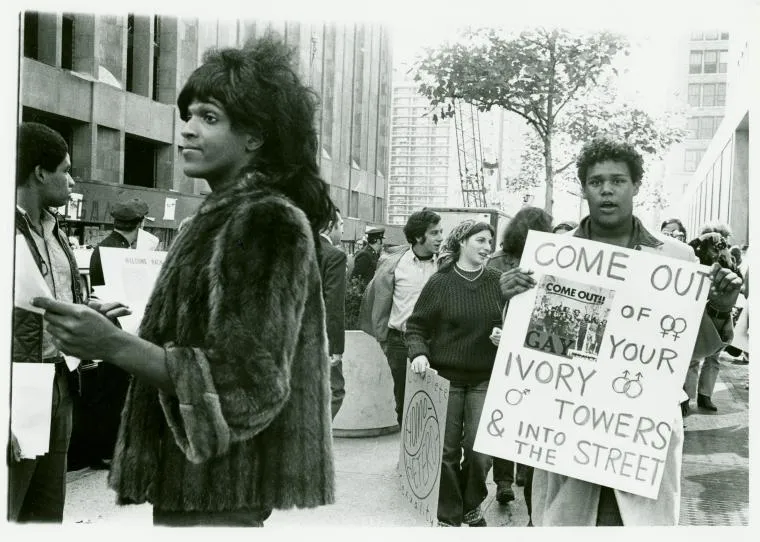New York City Monument Will Honor Transgender Activists Marsha P. Johnson and Sylvia Rivera
The two women were instrumental in the 1969 Stonewall Uprising and spent their lives advocating for marginalized groups
:focal(126x184:127x185)/https://tf-cmsv2-smithsonianmag-media.s3.amazonaws.com/filer/f9/05/f9053179-14f0-45fe-b7a2-c357a5cd3727/index.jpeg)
A new monument will commemorate Marsha P. Johnson and Sylvia Rivera, transgender activists, drag performers and close friends who played central roles in the 1969 Stonewall Uprising. The statue—one of six commissioned by public arts campaign She Built NYC for its first wave of women-centric installations—will be the “first permanent, public artwork recognizing transgender women in the world,” according to the City of New York.
Johnson and Rivera were prominent figures in the gay liberation movement and the Greenwich Village scene. Tireless advocates for homeless LGBTQ youth, those affected by H.I.V. and AIDS, and other marginalized groups, the pair were involved in the early days of the Gay Liberation Front, a radical organization that peaked in the immediate aftermath of Stonewall, and the Gay Activists Alliance, a more moderate and narrowly focused spin-off group. In 1970, Rivera and Johnson launched Street Transvestite Action Revolutionaries (STAR), an organization dedicated to sheltering young transgender individuals who were shunned by their families.
According to some accounts of the Stonewall Uprising, Johnson and Rivera were among the first to physically resist a police raid on the bar. However, historians have had trouble pinpointing the exact moment that sparked the riots, and as Chysanthemum Tran points out for them, both women denied in interviews being the very first to take action. To commemorate their involvement in this pivotal moment in the gay rights movement, the monument’s proposed location is just blocks away from the Stonewall Inn.
In an interview with Julia Jacobs of The New York Times, New York City’s first lady, Chirlane McCray, says that the planned monument will help give a “name and a face” to the overlooked activists. All too often, McCray adds, the fight for LGBTQ rights is “portrayed very much as a white, gay, male movement.” By spotlighting Johnson, who was black, and Rivera, who was Latina, the statue “counters that trend of whitewashing the history.”
Johnson was born in 1945; her father worked on a General Motors assembly line, and her mother was a housekeeper. According to The New York Times’ Sewell Chan, she left her hometown of Elizabeth, New Jersey, immediately after graduation with just $15 and a bag of clothes to her name. During the 1960s and ’70s, Johnson was heavily involved in the gay rights movement, attracting attention from the likes of artist Andy Warhol, who included her in a series of 1975 prints. As Hugh Ryan reports for Out, she spoke out against the transphobia exhibited by many gay men and advocated for a queer rights movement focused on reducing incarceration rates and homelessness—issues that continue to disproportionately affect transgender people. Johnson’s activism was born of personal experience: She spent most of her own life homeless and destitute and experienced severe mental illness. In the summer of 1992, Johnson’s body was found in the Hudson River. Although her death was initially deemed a suicide, authorities later changed this designation to drowning from undetermined causes. The case remains open to this day.

Rivera, meanwhile, was orphaned at age 3 and by age 11 was on the streets of New York working as a child prostitute. She was eventually taken in by the local drag queen community and became lifelong friends with Johnson. As her She Built NYC biography states, Rivera fought for drag culture and transgender individuals’ inclusion within the wider gay rights movement, stopping her work with the Gay Activists Alliance after it decided to eliminate transgender issues from its civil rights agenda in the early 1970s. In the years leading up to her death at age 50 in 2002, she campaigned for transgender rights to be protected under New York’s Sexual Orientation Non-Discrimination Act and briefly resurrected STAR under the new name Street Transgender Action Revolutionaries.
As Taylor Dafoe writes for artnet News, the city has issued an open call for artists interested in designing the work, which is currently slated to stand in Greenwich Village’s Ruth Wittenberg Triangle. Scheduled for completion by the end of 2021, the monument will cost an estimated $750,000, paid for out of $10 million allocated toward building new public artworks.
She Built NYC, the initiative behind the Johnson and Rivera statue, launched last summer with the goal of increasing the city’s ratio of statues depicting historical women to 50 percent. Previously, just five out of 145 monuments featured women.
As part of its efforts to rectify this gender imbalance, She Built NYC announced plans to commission five monuments, one for each borough of the city, earlier this year. Statues of the jazz singer Billie Holiday, civil rights advocate Elizabeth Jennings Graham, medical activist Helen Rodríguez Trías, lighthouse keeper Katherine Walker and first black congresswoman Shirley Chisholm will be installed in Queens, Manhattan, the Bronx, Staten Island and Brooklyn, respectively.
The public art featuring Rivera and Johnson will add transgender women to the short-but-growing roster of women depicted by the city’s monuments. As Alex Schmider, associate director of transgender representation at GLAAD, told the Guardian’s Nadja Sayej, the monument “will not only serve as a reminder of transgender women of color’s existence and persistence, but also send a message of reverence to the history and legacy of our community’s pioneers, without whom we would not be where we are today.”
/https://tf-cmsv2-smithsonianmag-media.s3.amazonaws.com/accounts/headshot/mellon.png)
/https://tf-cmsv2-smithsonianmag-media.s3.amazonaws.com/accounts/headshot/mellon.png)